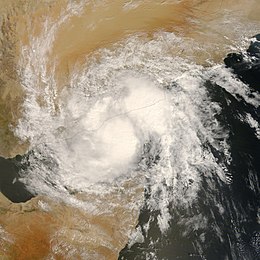2008 Yemen cyclone
| Deep depression (IMD scale) | |
|---|---|
| Tropical depression (Saffir–Simpson scale) | |

Depression ARB 02
|
|
| Formed | October 19, 2008 |
| Dissipated | October 23, 2008 |
| Highest winds |
3-minute sustained: 55 km/h (35 mph) 1-minute sustained: 55 km/h (35 mph) |
| Lowest pressure | 988 hPa (mbar); 29.18 inHg |
| Fatalities | 180 |
| Damage | $874.8 million (2008 USD) |
| Areas affected | Yemen |
| Part of the 2008 North Indian Ocean cyclone season | |
In October 2008, the remnants of a tropical cyclone caused extensive damage in Yemen, a poor country on the southern tip of the Arabian Peninsula. The storm, officially known as Deep Depression ARB 02, was the sixth tropical cyclone of the 2008 North Indian Ocean cyclone season, and the second tropical cyclone in the Arabian Sea that year. It formed on October 19 off the west coast of India from the same broader system that spawned a storm in the southern Indian Ocean. Moving generally westward, the depression failed to intensify much, reaching maximum sustained winds of only 55 km/h (35 mph). It was no longer classifiable as a tropical depression by October 23, and later that day, its remnants struck near Ash Shihr in eastern Yemen.
The storm sent a plume of moisture throughout the Arabian Peninsula, contributing to dust storms as far north as Iraq. However, the effects were most severe in Yemen, becoming the second-worst natural disaster in the country after deadly floods in 1996. The storm dropped heavy rainfall in a normally arid region, reaching around 91 mm (3.6 in), which caused flash flooding in valleys after waterways were unable to contain the approximately 2 billion km3 (528 billion gallons) of water that fell. Poor drainage practices and an invasive species of weed contributed to the floods, which damaged or destroyed 6,505 houses, leaving about 25,000 people homeless. The floods killed 180 people and severely disrupted the livelihoods of about 700,000 residents of Hadhramaut and Al Mahrah governorates, mostly farmers whose fields were washed away. Some of the buildings at the Shibam UNESCO World Heritage Site collapsed due to the floods. Overall damage was estimated at US$874.8 million, although residual losses from damaged infrastructure were estimated to cost an additional US$726.9 million. The overall economic impact of the storm was therefore estimated at US$1.638 billion, equating to roughly 6% of the country's gross domestic product.
...
Wikipedia
